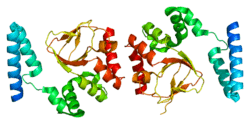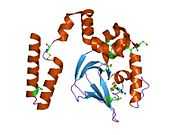HCN4
Potassium/sodium hyperpolarization-activated cyclic nucleotide-gated channel 4 is a protein that in humans is encoded by the HCN4 gene.[1][2][3][4]
There are four HCN channels. HCN4 is prominently expressed in the pace maker region of the mammalian heart.[5] Some humans with bradycardia and Sick sinus syndrome have been shown to have mutations in their HCN4 gene.[6][7] The role of HCN channels in autonomic control of heart rate is currently a matter of ongoing investigation.[8][9][10][11]
Interactions
HCN4 has been shown to interact with HCN2.[12]
See also
References
- ↑ Ludwig A, Zong X, Stieber J, Hullin R, Hofmann F, Biel M (Jun 1999). "Two pacemaker channels from human heart with profoundly different activation kinetics". EMBO J 18 (9): 2323–9. doi:10.1093/emboj/18.9.2323. PMC 1171315. PMID 10228147.
- ↑ Seifert R, Scholten A, Gauss R, Mincheva A, Lichter P, Kaupp UB (Sep 1999). "Molecular characterization of a slowly gating human hyperpolarization-activated channel predominantly expressed in thalamus, heart, and testis". Proc Natl Acad Sci U S A 96 (16): 9391–6. doi:10.1073/pnas.96.16.9391. PMC 17793. PMID 10430953.
- ↑ Hofmann F, Biel M, Kaupp UB (Dec 2005). "International Union of Pharmacology. LI. Nomenclature and structure-function relationships of cyclic nucleotide-regulated channels". Pharmacol Rev 57 (4): 455–62. doi:10.1124/pr.57.4.8. PMID 16382102.
- ↑ "Entrez Gene: HCN4 hyperpolarization activated cyclic nucleotide-gated potassium channel 4".
- ↑ Baruscotti, M.; Bucchi, A.; Viscomi, C.; Mandelli, G.; Consalez, G.; Gnecchi-Rusconi, T.; Montano, N.; Casali, K. R.; Micheloni, S.; Barbuti, A.; Difrancesco, D. (2011). "Deep bradycardia and heart block caused by inducible cardiac-specific knockout of the pacemaker channel gene Hcn4". Proceedings of the National Academy of Sciences 108 (4): 1705–1710. doi:10.1073/pnas.1010122108. PMC 3029742. PMID 21220308.
- ↑ Schulze-Bahr, E.; Neu, A.; Friederich, P.; Kaupp, U. B.; Breithardt, G. N.; Pongs, O.; Isbrandt, D. (2003). "Pacemaker channel dysfunction in a patient with sinus node disease". Journal of Clinical Investigation 111 (10): 1537–1545. doi:10.1172/JCI16387. PMC 155041. PMID 12750403.
- ↑ Laish-Farkash, A.; Glikson, M.; Brass, D.; Marek-Yagel, D.; Pras, E.; Dascal, N.; Antzelevitch, C.; Nof, E.; Reznik, H.; Eldar, M.; Luria, D. (2010). "A Novel Mutation in the Hcn4 Gene Causes Symptomatic Sinus Bradycardia in Moroccan Jews". Journal of Cardiovascular Electrophysiology 21 (12): 1365–1372. doi:10.1111/j.1540-8167.2010.01844.x. PMC 3005590. PMID 20662977.
- ↑ Larsson, H. P. (2010). "How is the heart rate regulated in the sinoatrial node? Another piece to the puzzle". The Journal of General Physiology 136 (3): 237–241. doi:10.1085/jgp.201010506. PMC 2931147. PMID 20713549.
- ↑ Schweizer, P. A.; Duhme, N.; Thomas, D.; Becker, R.; Zehelein, J.; Draguhn, A.; Bruehl, C.; Katus, H. A.; Koenen, M. (2010). "CAMP Sensitivity of HCN Pacemaker Channels Determines Basal Heart Rate but is Not Critical for Autonomic Rate Control". Circulation: Arrhythmia and Electrophysiology 3 (5): 542–552. doi:10.1161/CIRCEP.110.949768. PMID 20693575.
- ↑ Liao, Z.; Lockhead, D.; Larson, E. D.; Proenza, C. (2010). "Phosphorylation and modulation of hyperpolarization-activated HCN4 channels by protein kinase a in the mouse sinoatrial node". The Journal of General Physiology 136 (3): 247–258. doi:10.1085/jgp.201010488. PMC 2931151. PMID 20713547.
- ↑ Nof, E.; Antzelevitch, C.; Glikson, M. (2010). "The Contribution of HCN4 to Normal Sinus Node Function in Humans and Animal Models". Pacing and Clinical Electrophysiology 33 (1): 100–106. doi:10.1111/j.1540-8159.2009.02563.x. PMC 2865562. PMID 19796353.
- ↑ Much, Barbara; Wahl-Schott Christian, Zong Xiangang, Schneider Angela, Baumann Ludwig, Moosmang Sven, Ludwig Andreas, Biel Martin (Oct 2003). "Role of subunit heteromerization and N-linked glycosylation in the formation of functional hyperpolarization-activated cyclic nucleotide-gated channels". J. Biol. Chem. (United States) 278 (44): 43781–6. doi:10.1074/jbc.M306958200. ISSN 0021-9258. PMID 12928435.
Further reading
- Qu J, Altomare C, Bucchi A et al. (2003). "Functional comparison of HCN isoforms expressed in ventricular and HEK 293 cells.". Pflugers Arch. 444 (5): 597–601. doi:10.1007/s00424-002-0860-7. PMID 12194012.
- Schulze-Bahr E, Neu A, Friederich P et al. (2003). "Pacemaker channel dysfunction in a patient with sinus node disease.". J. Clin. Invest. 111 (10): 1537–45. doi:10.1172/JCI16387. PMC 155041. PMID 12750403.
- Stieber J, Thomer A, Much B et al. (2003). "Molecular basis for the different activation kinetics of the pacemaker channels HCN2 and HCN4.". J. Biol. Chem. 278 (36): 33672–80. doi:10.1074/jbc.M305318200. PMID 12813043.
- Decher N, Bundis F, Vajna R, Steinmeyer K (2004). "KCNE2 modulates current amplitudes and activation kinetics of HCN4: influence of KCNE family members on HCN4 currents.". Pflugers Arch. 446 (6): 633–40. doi:10.1007/s00424-003-1127-7. PMID 12856183.
- Much B, Wahl-Schott C, Zong X et al. (2003). "Role of subunit heteromerization and N-linked glycosylation in the formation of functional hyperpolarization-activated cyclic nucleotide-gated channels.". J. Biol. Chem. 278 (44): 43781–6. doi:10.1074/jbc.M306958200. PMID 12928435.
- Ueda K, Nakamura K, Hayashi T et al. (2004). "Functional characterization of a trafficking-defective HCN4 mutation, D553N, associated with cardiac arrhythmia.". J. Biol. Chem. 279 (26): 27194–8. doi:10.1074/jbc.M311953200. PMID 15123648.
- Michels G, Er F, Khan I et al. (2005). "Single-channel properties support a potential contribution of hyperpolarization-activated cyclic nucleotide-gated channels and If to cardiac arrhythmias.". Circulation 111 (4): 399–404. doi:10.1161/01.CIR.0000153799.65783.3A. PMID 15687126.
- Milanesi R, Baruscotti M, Gnecchi-Ruscone T, DiFrancesco D (2006). "Familial sinus bradycardia associated with a mutation in the cardiac pacemaker channel.". N. Engl. J. Med. 354 (2): 151–7. doi:10.1056/NEJMoa052475. PMID 16407510.
- Elinder F, Männikkö R, Pandey S, Larsson HP (2006). "Mode shifts in the voltage gating of the mouse and human HCN2 and HCN4 channels.". J. Physiol. (Lond.) 575 (Pt 2): 417–31. doi:10.1113/jphysiol.2006.110437. PMC 1819464. PMID 16777944.
- Nof E, Luria D, Brass D et al. (2007). "Point mutation in the HCN4 cardiac ion channel pore affecting synthesis, trafficking, and functional expression is associated with familial asymptomatic sinus bradycardia.". Circulation 116 (5): 463–70. doi:10.1161/CIRCULATIONAHA.107.706887. PMID 17646576.
External links
- GeneReviews/NIH/NCBI/UW entry on Brugada syndrome
- HCN4 protein, human at the US National Library of Medicine Medical Subject Headings (MeSH)
- HCN4 human gene location in the UCSC Genome Browser.
- HCN4 human gene details in the UCSC Genome Browser.
This article incorporates text from the United States National Library of Medicine, which is in the public domain.
| |||||||||||||
| ||||||||||||||||||||||||||||||||||||||||||||||||||||||||||||||||||||||||||||||||||||||||||||||||||||||||||||||||||||||||




